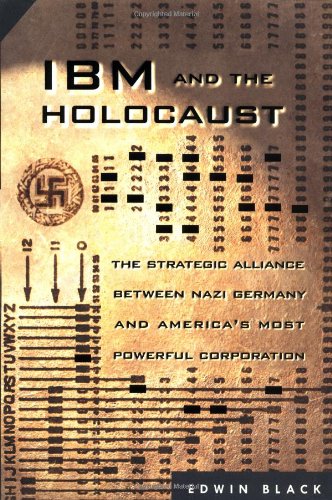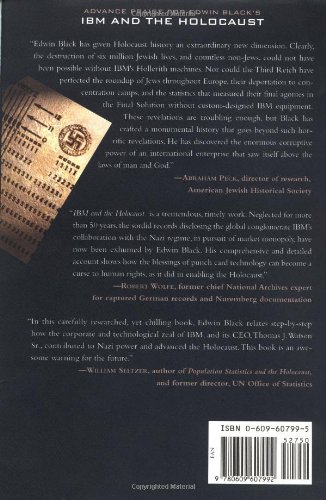Description
IBM and the Holocaust is the stunning story of IBM’s strategic alliance with Nazi Germany — beginning in 1933 in the first weeks that Hitler came to power and continuing well into World War II. As the Third Reich embarked upon its plan of conquest and genocide, IBM and its subsidiaries helped create enabling technologies, step by step, from the identification and cataloging programs of the 1930s to the selections of the 1940s.
Only after Jews were identified — a massive and complex task that Hitler wanted done straight away — could they be targeted for efficient asset confiscation, ghettoization, deportation, enslaved labor, and, in the end, annihilation. It Used to be a cross-tabulation and organizational challenge so monumental, it known as for a pc. Of course, in the 1930s no computer existed.
But IBM’s Hollerith punch card technology did exist. Aided by the company’s custom-designed and continuously up to date Hollerith systems, Hitler Used to be in a position to automate his persecution of the Jews. Historians have at all times been amazed on the speed and accuracy with which the Nazis were in a position to identify and locate European Jewry. Until now, the pieces of this puzzle have never been fully assembled. The fact is, IBM technology Used to be used to organize nearly the whole lot in Germany and then Nazi Europe, from the identification of the Jews in censuses, registrations, and ancestral tracing programs to the running of railroads and organizing of concentration camp slave labor.
IBM and its German subsidiary custom-designed complex solutions, one after the other, anticipating the Reich’s needs. They didn’t merely sell the machines and walk away. As an alternative, IBM leased these machines for high fees and became the sole source of the billions of punch cards Hitler needed.
IBM and the Holocaust takes you through the carefully crafted corporate collusion with the Third Reich, in addition to the structured deniability of oral agreements, undated letters, and the Geneva intermediaries — all undertaken as the newspapers blazed with accounts of persecution and destruction.
Just as compelling is the human drama of one of our century’s greatest minds, IBM founder Thomas Watson, who cooperated with the Nazis for the sake of profit.
Only with IBM’s technologic assistance Used to be Hitler in a position to reach the staggering numbers of the Holocaust. Edwin Black has now uncovered some of the last great mysteries of Germany’s war against the Jews — how did Hitler get the names?
Used to be IBM, “The Solutions Company,” partly answerable for the Final Solution? That is the question raised by Edwin Black’s IBM and the Holocaust, the most controversial book on the subject since Daniel Jonah Goldhagen’s Hitler’s Willing Executioners. Black, a son of Holocaust survivors, is less tendentiously simplistic than Goldhagen, but his thesis is no less provocative: he argues that IBM founder Thomas Watson deserved the Merit Cross (Germany’s second-highest honor) awarded him by Hitler, his second-biggest customer on the planet. “IBM, primarily through its German subsidiary, made Hitler’s program of Jewish destruction a technologic mission the company pursued with chilling success,” writes Black. “IBM had almost single-handedly brought up to date warfare into the information age [and] virtually put the ‘blitz’ in the krieg.”
The a very powerful technology Used to be a precursor to the computer, the IBM Hollerith punch card machine, which Black glimpsed on exhibit on the U.S. Holocaust Museum, inspiring his five-year, top-secret book project. The Hollerith Used to be used to tabulate and alphabetize census data. Black says the Hollerith and its punch card data (“hole 3 signified homosexual … hole 8 designated a Jew”) Used to be indispensable in rounding up prisoners, keeping the trains fully packed and on time, tallying the deaths, and organizing all the war effort. Hitler’s regime Used to be fantastically, suicidally chaotic; could IBM have been the reason for its sole competence: mass-murdering civilians? Better scholars than I will have to sift through and appraise Black’s mountainous evidence, but clearly the assessment is overdue.
The moral argument turns on one question: How much did IBM New York know about IBM Germany’s work, and when? Black documents a scary game of brinksmanship orchestrated by IBM chief Watson, who walked a fine line between enraging U.S. officials and infuriating Hitler. He shamefully delayed returning the Nazi medal until forced to–and when he did return it, the Nazis almost kicked IBM and its a very powerful machines out of Germany. (Hitler Used to be vulnerable to self-defeating decisions, as demonstrated in How Hitler Could Have Won World War II.)
Black has created a will have to-read work of history. But it is also an interesting business book examining the colliding influences of personality, morality, and cold strategic calculation. –Tim Appelo
Frequently Bought Together
-
This item: IBM and the Holocaust: The Strategic Alliance between Nazi Germany and America's Most Powerful Corporation$19.90
-
$14.98
-
$29.95
-
$31.56






